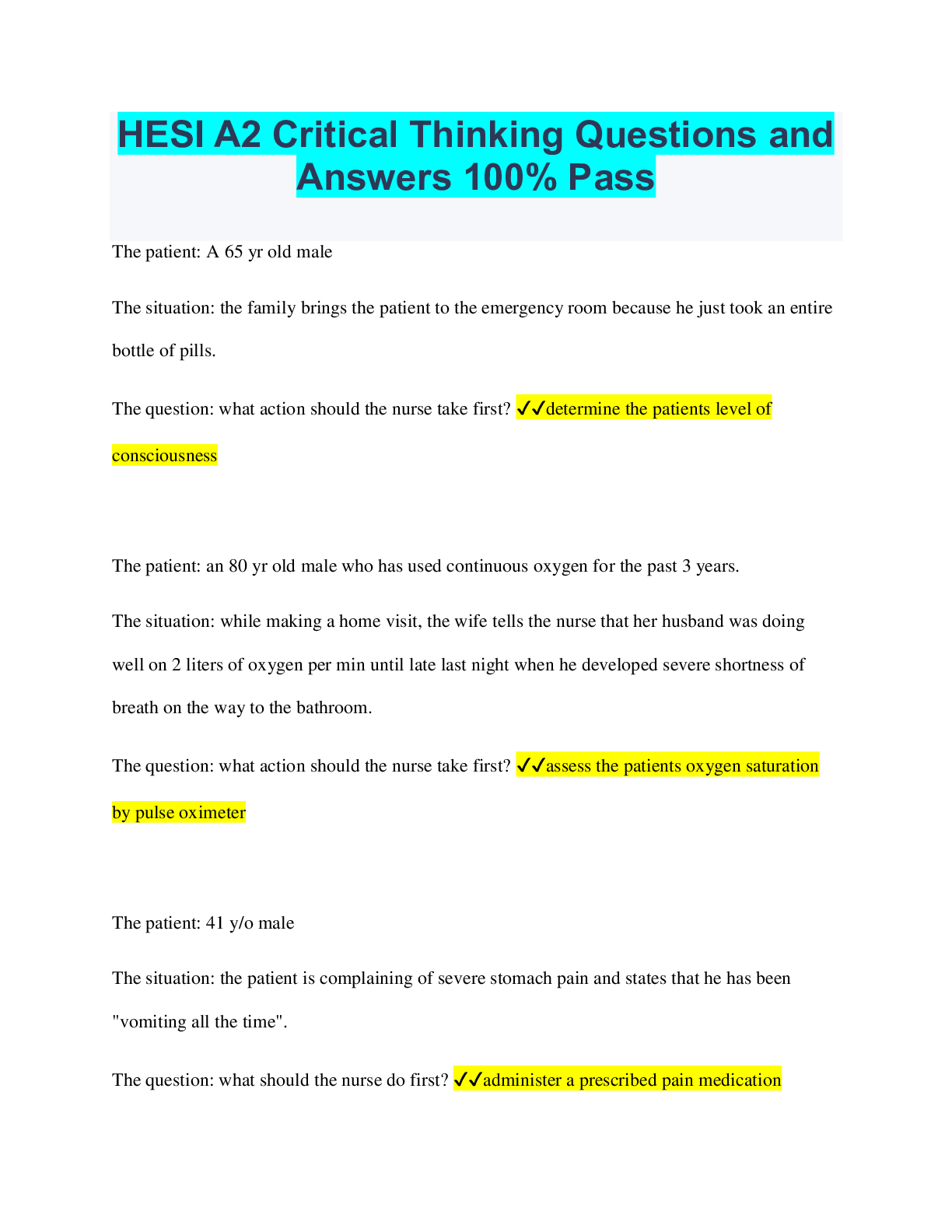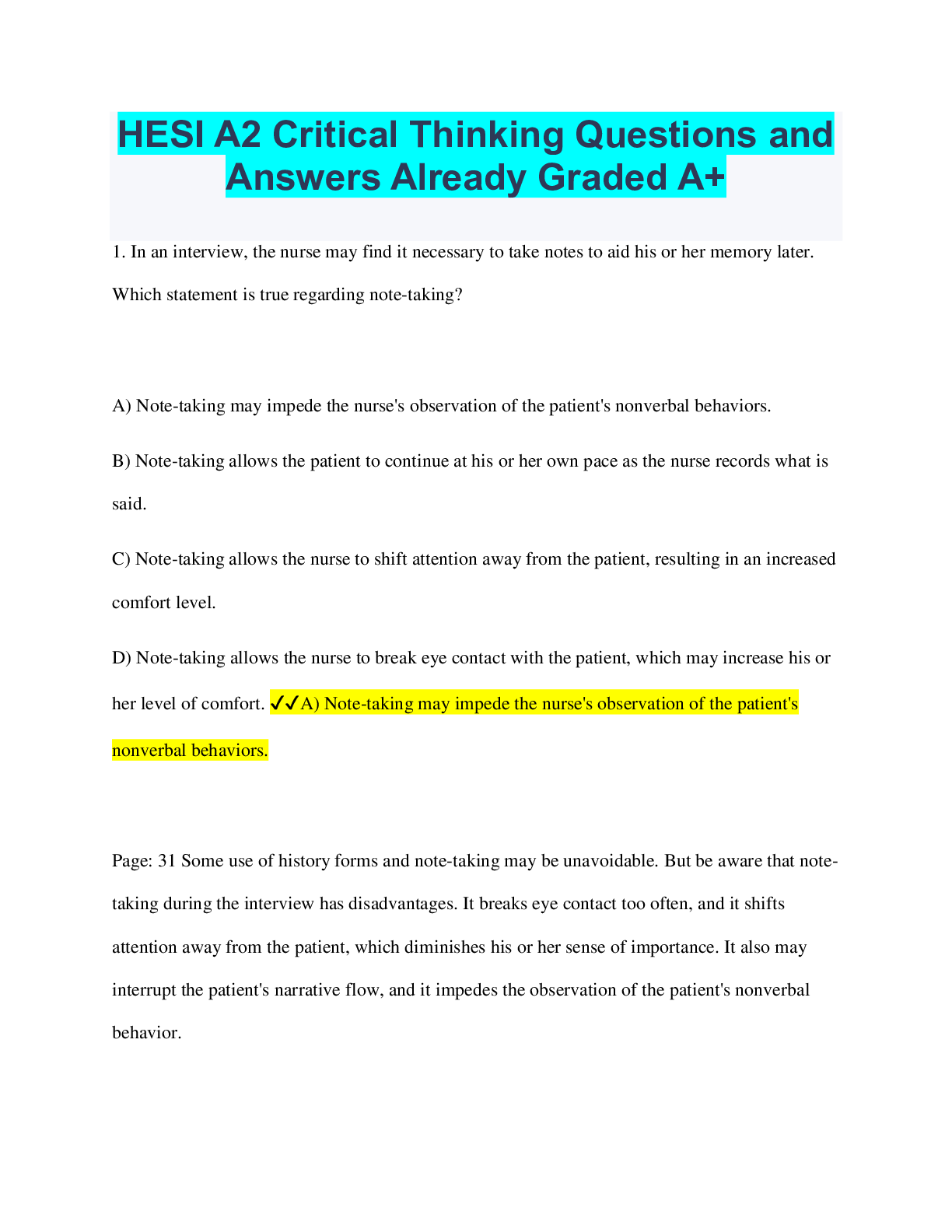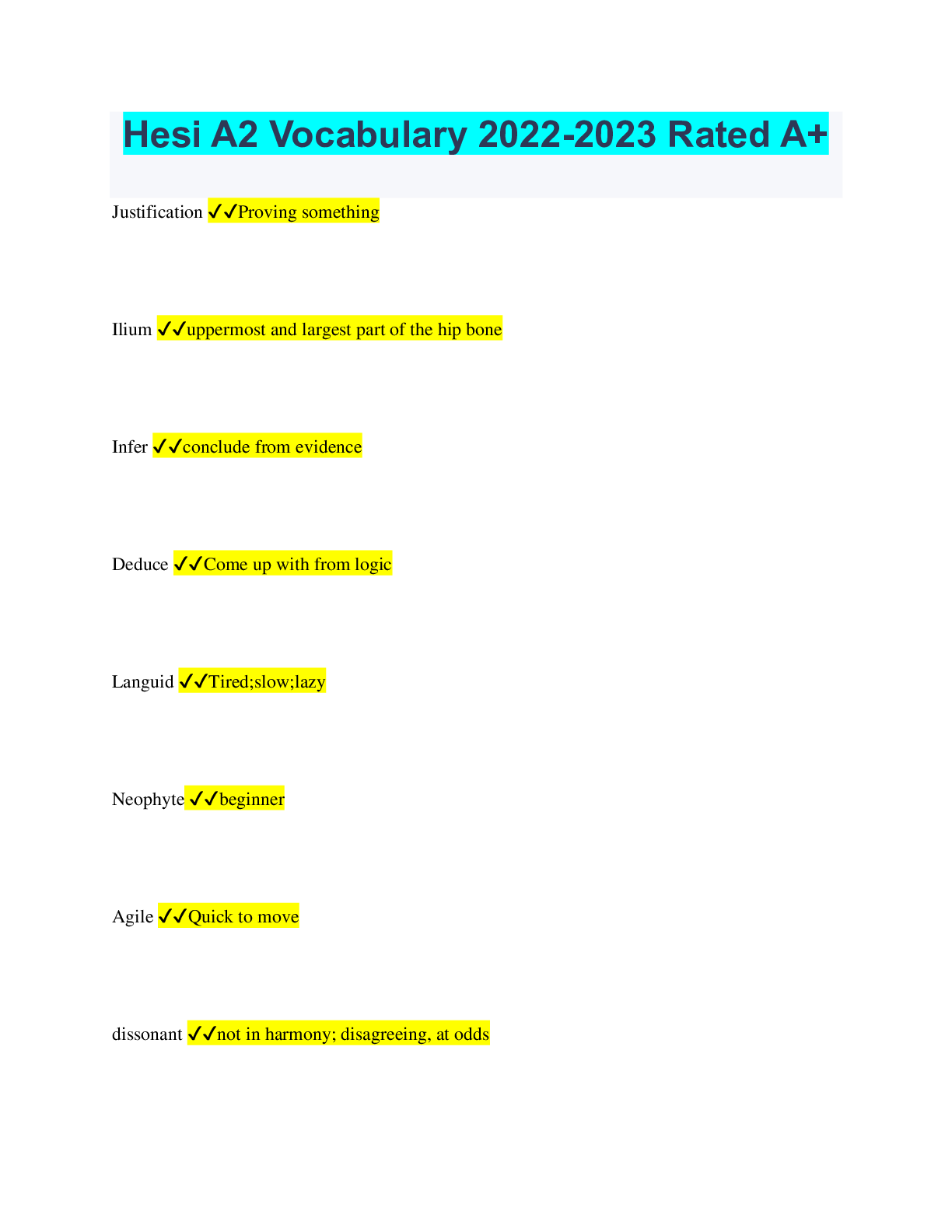Software Engineering > QUESTIONS & ANSWERS > WGU C857 - Software Quality Assurance Latest 2022 Graded A+ (All)
WGU C857 - Software Quality Assurance Latest 2022 Graded A+
Document Content and Description Below
WGU C857 - Software Quality Assurance Latest 2022 Graded A+ 3 Types of Acceptance Tests ✔✔Benchmark, Pilot, Parallel (details below) Benchmark tests ✔✔tests ran by users using *predefined ... test cases* Pilot tests ✔✔tests ran by users under *normal or everyday situation* Beta testing ✔✔done at customer's site Alpha testing ✔✔done at developer's site Parallel test ✔✔New system operates in parallel with previous version to make transition easier for user LOC measurement of productivity ✔✔Error per line of code is better. LOC is not good for all programs because it is hard to measure. Some programs only use one line. Cyclomatic complexity ✔✔a measure of the complexity of a module's decision structure. Module Design Complexity ✔✔iv(G); is the cyclomatic number for the module Design Complexity ✔✔SO; sum of iv(G) for itself and all decedents Integration complexity ✔✔S1; SO - n + 1 Module Integration testing ✔✔evaluate just the module and its immediate children Design Integration testing ✔✔evaluate the entire graph White box testing ✔✔look into program graph at cyclomatic #, basis, IP, DU path coverage, and program slice Functional testing ✔✔do not look at program structure, only at the specifications or requirements Unit level testing ✔✔White box and functional testing of each module Integration testing ✔✔integrate modules, that have been tested at unit level Unit and Functional testing ✔✔verification that the programmer implemented the design correctly System testing ✔✔validation that the system does what the customer wants it to do *System testing steps* ✔✔functional testing, performance testing, acceptance testing, installation testing *Function point* ✔✔used early in lifecycle at requirements analysis as a mechanism to estimate the project with the use of a historical baseline for comparison *Function point factors* ✔✔Inputs, Outputs, User inquiries, Data files to be accessed, Interfaces to other applications Weights for factors ✔✔reflects the approximate difficulty associate with implementing each of the 5 factors Complexity adjustment ✔✔reflects the complexity of the whole application Metric ✔✔is an interpretation of a set of data points, and is used as a measurement process Key to estimating size ✔✔having a historical baseline of performance to use for comparison Halstead Metrics ✔✔Linguistic metrics; predicts the number of bugs in the software. McCabe Metrics ✔✔Structural Metrics; used to measure complexity for testing; used for integration testing Complexity Profile Graph (CPG) ✔✔creates a profile and not just a single number to indicate the software's complexity. The profile gives a graph to indicate complexity of each line of code. It also gives the overall software complexity. It is based off of values from each measurable unit. Segment (CPG) ✔✔is a bar in the graph; it is computed based off of content, breadth, reachability, inherent, total of all Maintainability Index (MI) ✔✔used after the system is developed; the smaller the number the better. Big Bang Integration ✔✔Test each module and then all of it together. Modules will need either drivers, stubs (defined below), or both depending on what layer. 2 step approach. Drivers ✔✔needed for integration testing when the module is not the very top module and relies on higher modules to test it. Stubs ✔✔needed for integration testing when the module is not the very bottom and must rely on lower modules for testing it. Big Bang Flaws ✔✔Not good for large systems. Does not scale well. Difficult or impossible to isolate faults Bottom up Integration ✔✔Need drivers to test from bottom module and move up. Good for O/O system because you start with basic components. Bottom up flaws ✔✔Not appropriate functionally decomposed system because they usually start from the top. Discovering major faults can be delayed. Doesn't reveal timing errors. Not good when there is a lot of interactions between components. Top down Integration ✔✔Need stubs to test the top modules by making sure bottom modules will work. Done when major functionality exists at the top level, functionally decomposed systems. Top down flaws ✔✔Using stubs can be complex and their correctness will influence the validity of the test. Lack of individual testing on the interior components. Sandwich Integration ✔✔Uses both top down and bottom up approach. Key is to identify a target level, somewhere in the middle. Everything on top is top down and everything below is bottom up. Will need stubs and drivers. Breadth (CPG) ✔✔number of statements within a construct Content (CPG) ✔✔ln(reserved words + operators + operands) Reachability (CPG) ✔✔number of operators in predicate path + 1 Inherent (CPG) ✔✔assigned value based on type of control structure Total ✔✔summation of breadth, content, reachability, inherent, with scaling factors associated with each one. Different Functional Tests ✔✔Test to pass, Test to fail, Blackbox, Dynamic (details below) Test to pass details ✔✔Done first to make sure it can work with simple test cases. Not trying to find bugs or break it Test to fail details ✔✔After test to pass. The purpose is to break the software and find bugs. Dynamic ✔✔Tests done with the software running [Show More]
Last updated: 2 years ago
Preview 1 out of 5 pages
.png)
Buy this document to get the full access instantly
Instant Download Access after purchase
Buy NowInstant download
We Accept:

Also available in bundle (1)
.png)
WGU C857 BUNDLED EXAMS QUESTIONS AND ANSWERS WITH VERIFIED SOLUTIONS (All Graded A)
WGU C857 BUNDLED EXAMS QUESTIONS AND ANSWERS WITH VERIFIED SOLUTIONS (All Graded A)
By Nutmegs 2 years ago
$20
10
Reviews( 0 )
$7.00
Can't find what you want? Try our AI powered Search
Document information
Connected school, study & course
About the document
Uploaded On
Sep 23, 2022
Number of pages
5
Written in
Additional information
This document has been written for:
Uploaded
Sep 23, 2022
Downloads
0
Views
169














.png)
.png)



